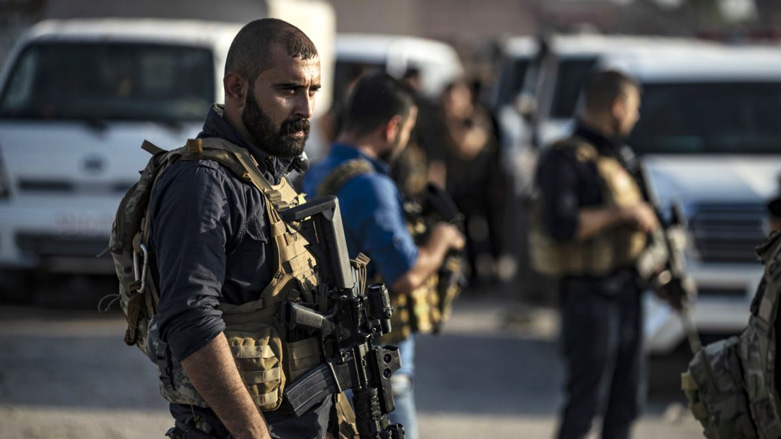Turkish-backed groups increase attacks on SDF positions despite ceasefire agreements
“It’s a mess in Tal Tamr and fronts between us and Turkey-backed militias.”

ERBIL (Kurdistan 24) – Turkish-backed groups have increased attacks this week on the Kurdish-led Syrian Democratic Forces (SDF) positions despite ceasefire agreements Turkey has with both the US and Russia.
Turkish-backed groups routinely bomb the town of Ain al-Issa and its countryside, Qeret Zarkan, Tal Tamr, and the Serekaniye (Ras al-Ain) countryside.
#BREAKING: HEAVY ARTILLERY#AIN_ISSA // The occupying #Turkish state and its armed groups bombing Seda village, Malik village, Ain Issa camp, and the international road M4 with heavy artillery.#Syria #Rojava pic.twitter.com/jD6P37wGCG
— Rojava Media Center (@Rojava_Media) November 27, 2020
Aram Hanna, spokesperson of the Syriac Military Council (SMC) and a senior military commander, told Kurdistan 24 on Tuesday that Turkish-backed groups targeted the Ain al Issa camp that day. They struck the local hospital and its surroundings with artillery and light weapons, he said.
“It’s a mess in Tal Tamr and fronts between us and Turkey-backed militias.”

He added that though Turkish drone strikes have declined, artillery attacks have increased. SMC was founded in 2013 to protect Christian populations in Syria and is part of the SDF, a conglomeration of armed groups backed by the US-led Coalition.
“The situation there is terrible; the attacks do not stop,” Hanna said. “Even the Russians and the [Syrian] regime forces do not stop it.”
“We have like a world cup there, and no one can do anything. Especially on the M4 (international) road, if you move on the M4 road, you can find international coalition forces, Syrian regime forces, Russian forces, FSA (Free Syrian Army) forces.”
He added that the Turkish attacks increased after the November 3 US elections. “There are more movements now than during the US elections.”
After Turkey conducted a cross-border attack into northeastern Syria in October 2019, Russia and the US reached separate ceasefire deals with Ankara, which allowed Turkish troops to control the area between Tal Abyad and Serekaniye.
Although US President Donald Trump initially decided last year to withdraw US forces from northeast Syria following a phone conversation with Turkish President Recep Tayyip Erdogan, he was later convinced to keep troops in the northeast to prevent the oil fields from falling into the hands of Iran or the Islamic State.
As a result, there are still US troops in the Hasakah and Deir al-Zor, which contain the majority of Syria’s oil resources even as the US withdrew from bases surrounding Kobani, Manbij, and Raqqa that were later taken over by the Russian military. The Russians also took over one US base in Ain al Issa.
Despite the agreements, Turkish-backed groups and the Turkish army itself continue to target SDF-held areas periodically. In some cases, villagers living in Syrian-Turkish border areas were killed in attacks by the Turkish military and the rebel forces Ankara supports.
“We had a calm situation in the last few months, but the last week we had more movements on the Turkish side, especially Ain al Issa front, that’s why we had responsibility to prevent any attempts for invasion or attacks by the militias supported by Turkey, that’s what I think led to the confrontations during the last few days,” SDF spokesperson Kino Gabriel told Kurdistan 24 on Friday.

“I think there is a need for more focus from the countries guaranteeing the ceasefire, especially the US and Russia, to make Turkey abide by those agreements and stop these attempts to gain more control.”
Gabriel also denied that the SDF tried to infiltrate areas under Turkish control. “It is the Turkish supported militias that start confrontations and attack with light weapons, artillery, or rockets.”
Commander Aram Hanna stated that Turkey and its militant proxies must end their ceasefire violations.
“We are not attacking; we respect the ceasefire,” he added. “We lost a lot of civilians, properties, and fighters last year (in October). We are ready to defend ourselves if they attack our land.”
He affirmed, however, that this issue should be solved diplomatically, not through war. “We want peace,” Hanna added, expressing hope that the incoming US president, Joe Biden, will solve calm the tensions.
“He has to stop them, so they have to respect the agreement between them and US vice president Pence.”
Ilham Ahmed, President of the Executive Committee of the Syrian Democratic Council (SDC), during an interview with Kurdistan 24 on Wednesday, also said Russia is partially responsible for the increased Turkish attacks near Ain al Issa.
“The Russian forces are in this region. If there is shelling there, it’s the responsibility of Russia,” she said, and stated that “those who signed the agreement with Turkey should follow their commitments.”
After #Russia intervened to mediate between the Syrian Democratic Forces and the mercenaries of the Turkish occupation in the Ain Issa region.
— Yekîneyên Servanên Efrînê (@Servanenefrine1) November 25, 2020
The SDF committed themselves to a ceasefire and also allowed the mercenaries of the #Turkish occupation to withdraw their bodies as well pic.twitter.com/Savj2GqsZN
On November 24, Turkish-backed launched a big attack on SDF positions near Ain al Issa. According to the Syrian Observatory for Human Rights (SOHR), at least 31 Turkish-backed militiamen were killed.
After Russian mediation, the slain fighters were returned, which according to SOHR and the Rojava Information Centre (RIC) included the body of an ex-ISIS senior leader, Ismail Aydo, who previously served in Tal Abyad.
Ismail Aydo, a one-time ISIS emir handling weapons & finance, has been confirmed killed during an assault by Turkish-backed forces on SDF-held Ain Issa.
— Rojava Information Center (@RojavaIC) November 24, 2020
He was one of 40+ ISIS members now part of Turkish-backed forces identified in this @RojavaIC report:https://t.co/X8EtsYgiJf
The RIC on Friday evening reported yet another shelling Turkish-backed groups carried out, targeting the Seda village, Malik village, Ain al Issa camp, and the international road M4 with heavy artillery.
Editing by Khrush Najari